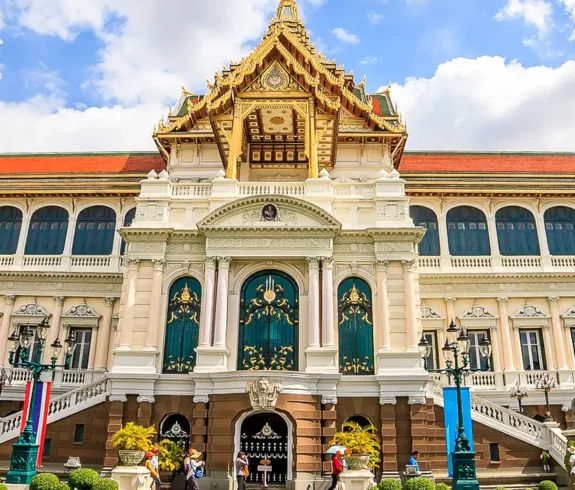The Bangkok Kings Palace, also known as Bangkok’s Grand Palace, is a magnificent symbol of Thailand’s history and culture. This edifice in downtown Bangkok dates back to 1782 and the reign of King Rama I, the founder of the Chakri Dynasty.
Bangkok’s Grand Palace has served as the official residence of Thai kings and the country’s administrative center for over 150 years. Today, while it no longer serves as a royal residence, it remains a cornerstone of Thai heritage, attracting millions of visitors annually.
The Significance of Bangkok Kings Palace
The Bangkok Kings Palace was established as the seat of the Rattanakosin Kingdom, symbolizing the unity and strength of the Thai people. It served as a center for royal ceremonies, state functions, and governance. The palace was also home to the Emerald Buddha at Wat Phra Kaew, Thailand’s most revered religious relic.
Over the years, the palace has undergone multiple renovations and expansions, reflecting the blend of Thai and Western architectural influences. Its grandeur continues to inspire awe, representing the rich cultural identity of Thailand.
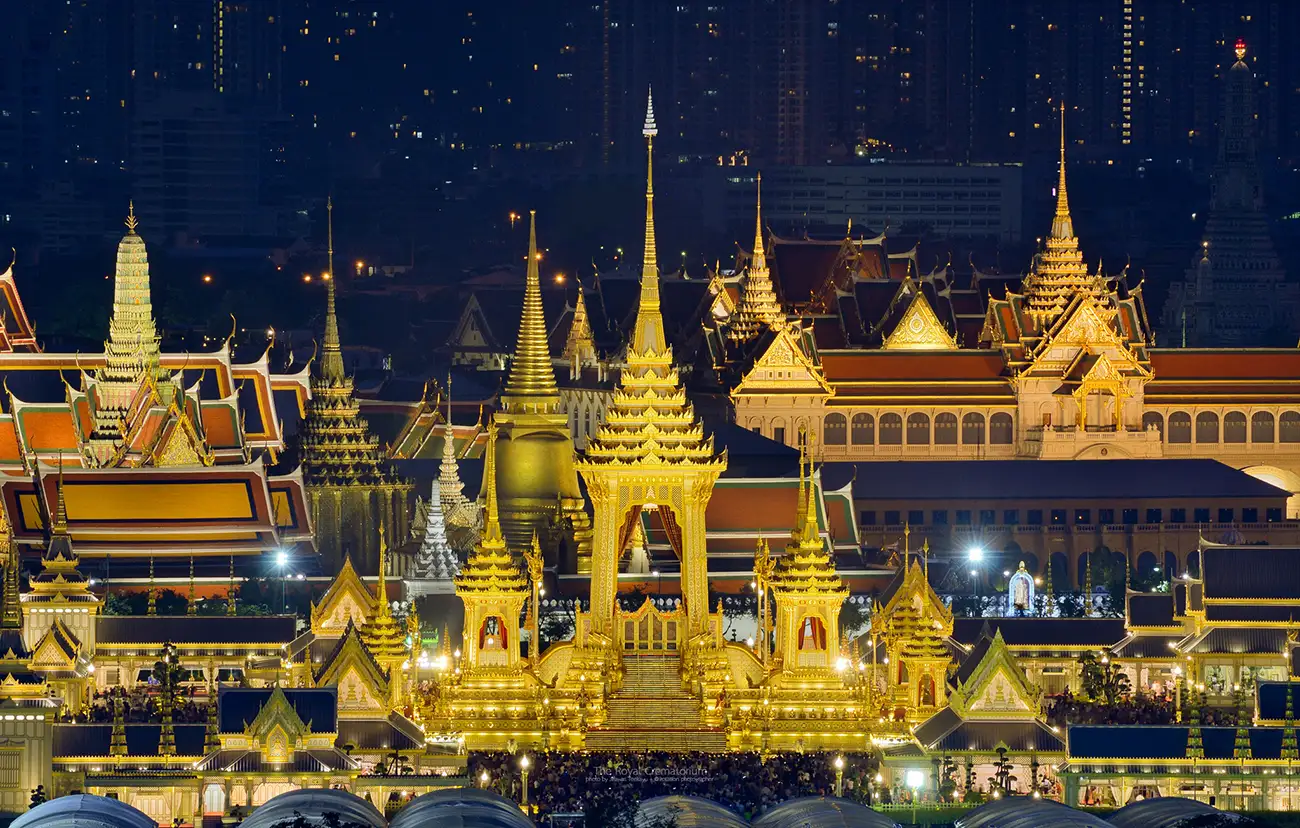
Evolution Through the Centuries
Since its construction, the Bangkok Kings Palace has witnessed Thailand’s transformation, standing resilient through political and social changes. Initially built as a wooden structure, it expanded under successive kings into a sprawling complex featuring halls, courtyards, and pavilions.
Each monarch contributed to its architecture, ensuring the palace remained a vibrant testament to Thai artistry and craftsmanship. It now operates as a ceremonial location and a highly recommended stop for visitors seeking to discover Thailand’s royal past.
Why Visit Bangkok Kings Palace?
Visiting the Bangkok Kings Palace offers an opportunity to enter Thailand’s royal history pages. With its intricate designs, cultural significance, and central role in Thai traditions, it’s a landmark that showcases the country’s enduring pride and identity.
This introductory content captures the essence of the Bangkok Kings Palace, laying a foundation for further exploration of its architecture, cultural significance, and visitor tips in subsequent sections. Short sentences and active voice ensure easy readability for all audiences.
Architectural Marvels of Thai Heritage
The Bangkok Kings Palace, also known as Bangkok’s Grand Palace, is a treasure trove of architectural brilliance. Built with precision and artistry, the palace complex reflects the grandeur of Thai culture and a blend of Western influences. Each structure within the complex tells a story of craftsmanship, history, and royal traditions.
Main Structures
The Chakri Maha Prasat Hall
One of the most remarkable features of the palace is the Chakri Maha Prasat Hall. Built-in 1882 during King Rama V’s reign, this grand hall showcases a fascinating combination of Thai and European architectural styles. Its lower levels boast Western-style columns and arches, while the upper sections retain traditional Thai tiered roofs.
Originally constructed as a royal reception hall, it now serves as a venue for important ceremonies. Its unique design highlights the influence of Western architecture on Thai royal projects during the late 19th century.
Wat Phra Kaew, aka Temple of the Emerald Buddha
The Temple of the Emerald Buddha is the spiritual heart of the Bangkok Kings Palace. Housing the revered Emerald Buddha, this temple is adorned with intricate murals, golden spires, and mythical statues. The temple’s design represents classical Thai architecture, with vibrant colors and elaborate carvings.
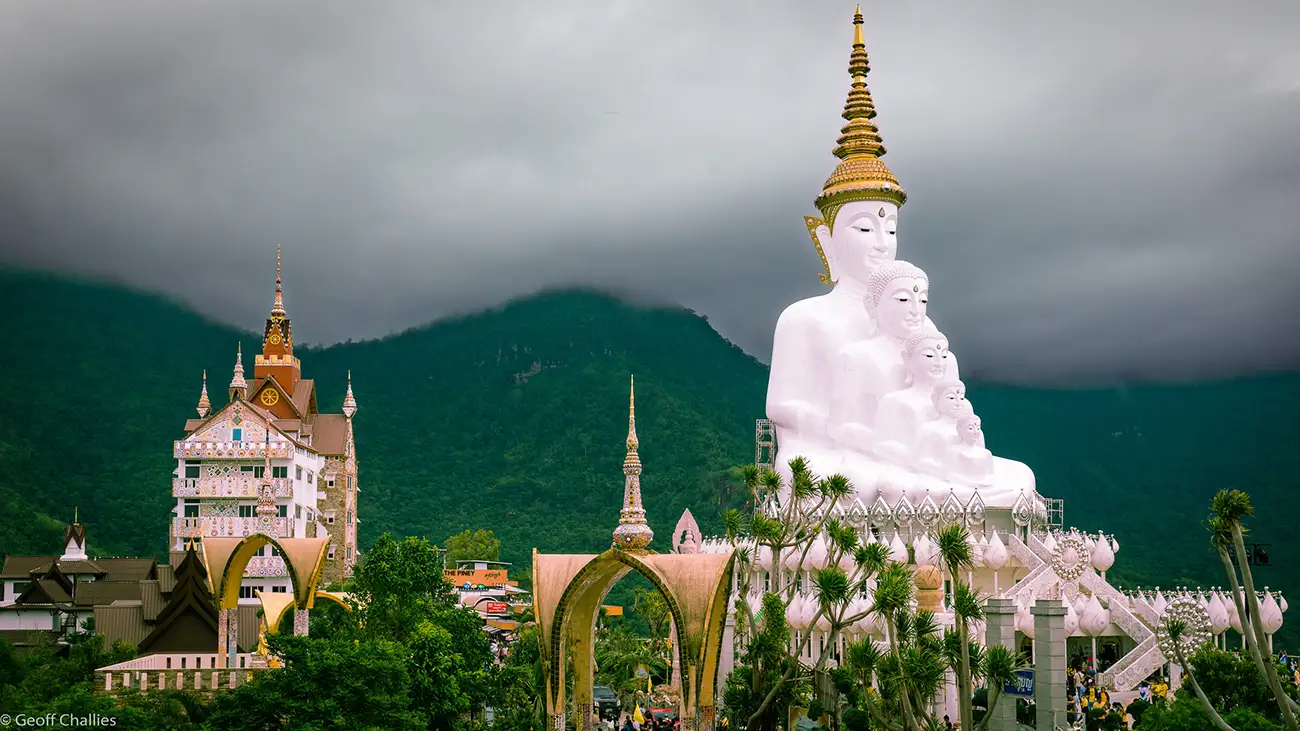
The Dusit Maha Prasat Hall
Built as a throne hall for King Rama I, the Dusit Maha Prasat Hall is a masterpiece of traditional Thai design. Its single-tiered roof and golden spire reflect the simplicity and elegance of Thai architecture. The hall is often used for royal ceremonies and showcases exquisite interior decorations, including ornate wooden carvings and murals.
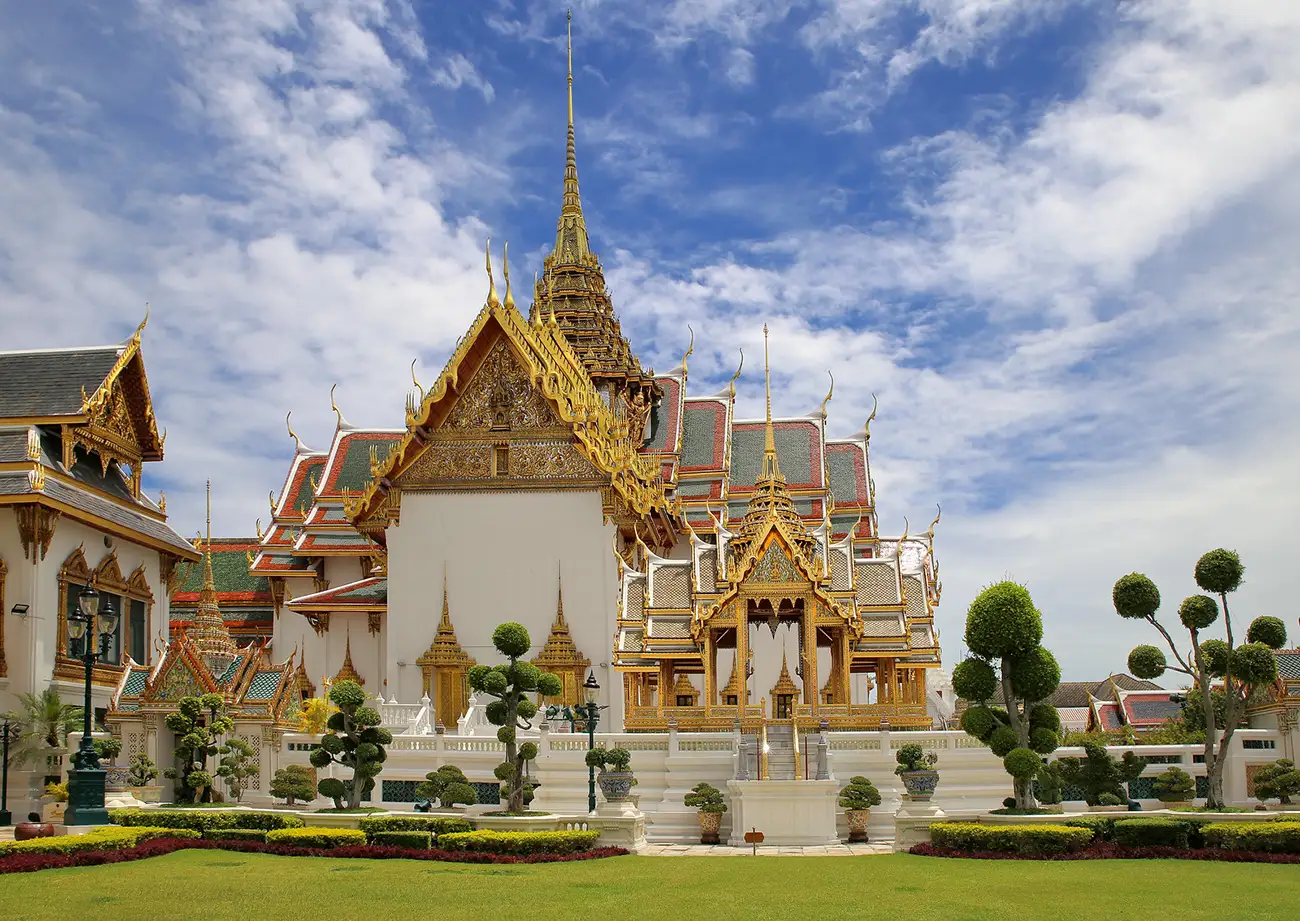
Thai Architectural Styles and Western Influences
The Bangkok King’s Palace is a harmonious blend of traditional Thai elements and Western aesthetics. Traditional structures feature iconic tiered roofs, intricately designed gables, and colorful porcelain tiles. These designs represent the cultural values of Thailand, including reverence for Buddhism and respect for the monarchy.
During King Rama V’s reign, European influences were integrated into the palace’s design. This is evident in the Chakri Maha Prasat Hall, where Italian Renaissance elements meet Thai motifs. The palace symbolizes Thailand’s ability to embrace modernity while honoring its traditions.
A Visual Feast for Visitors
Visitors are fascinated by the beauty and cultural importance of the Bangkok Kings Palace’s elaborate details. The vibrant colors, golden spires, and detailed carvings make it a photographer’s paradise. Every corner of the palace exudes craftsmanship and artistic dedication.
The Bangkok Kings Palace’s architectural wonders reflect Thailand’s rich heritage and openness to global influences. A visit here offers insights into the cultural and historical identity of the country while celebrating its timeless artistry.
Temple of the Emerald Buddha (Wat Phra Kaew)
Wat Phra Kaew, or the Temple of the Emerald Buddha as it is also known, serves as the spiritual heart of the Bangkok Kings Palace. This sacred site houses the revered Emerald Buddha, symbolizing Thailand’s deep-rooted Buddhist traditions and cultural identity. Visiting this iconic temple offers a glimpse into the spiritual essence of Thai culture.
Importance of the Emerald Buddha
The Emerald Buddha is a national treasure and holds immense significance in Thailand. This sacred statue, sculpted from a single piece of green jade, is regarded as a guardian of the nation. It is believed to bring the Thai people prosperity, peace, and good fortune.
The statue sits on a high golden pedestal within the temple, symbolizing its supreme importance in Thai Buddhism. The Emerald Buddha is dressed in seasonal robes, which the Thai king changes three times a year during a special ceremony. This act reflects the interconnection between the monarchy and Buddhism, emphasizing their shared role in Thai society.
Guidelines for Visiting Wat Phra Kaew
Visitors must follow specific rules and customs to appreciate the Temple of the Emerald Buddha fully. Respectful behavior is essential to honor the spiritual significance of this sacred site.
1. Dress Code
When entering the temple, visitors should ensure their attire is modest. Ensure your shoulders and knees are covered. Avoid wearing tight or revealing clothing. If needed, sarongs are available for rent at the entrance.
2. Footwear Removal
Before entering the temple area, you must remove your shoes. Designated areas are provided for footwear. Wearing socks is acceptable if you prefer.
3. Maintain Silence
The temple is a place of worship and reflection. Speak softly to maintain a peaceful atmosphere.
4. No Photography Inside the Main Hall
While photography is allowed in some areas of the temple complex, it is strictly prohibited inside the main hall where the Emerald Buddha resides.
5. Avoid Touching Sacred Objects
Do not touch or point at any statues or sacred items. These objects hold great religious value.
Practical Tips for Visitors
- Best Time to Visit: For smaller crowds, it’s best to visit either early in the morning or late in the afternoon.
- Tickets: Entry to Bangkok Kings Palace includes access to Wat Phra Kaew.
- Guided Tours: A guided tour can provide valuable insights into the temple’s history and symbolism.
The Temple of the Emerald Buddha is a key highlight of the Bangkok Kings Palace and a spiritual beacon for Thailand. Following the guidelines ensures a respectful and enriching experience, allowing you to connect with the culture and traditions of this remarkable country.
Cultural and Religious Significance
The Bangkok Kings Palace, also known as Bangkok’s Grand Palace, is more than an architectural marvel. It is a cultural and spiritual hub reflecting Thailand’s royal traditions and Buddhist values. From hosting grand ceremonies to showcasing symbolic art, the palace is vital in preserving Thai heritage.
Ceremonies and Royal Events
The Bangkok Kings Palace has been the venue for many significant ceremonies and royal events over the centuries. While the monarchy no longer resides here, the palace remains essential to Thailand’s cultural fabric.
1. Coronation Ceremonies
The palace is the traditional site for coronations of Thai kings. The grand halls and courtyards come alive with elaborate rituals symbolizing the monarchy’s divine connection to Buddhism.
2. State Functions
The palace hosts state banquets and receptions for visiting dignitaries. These events highlight the nation’s hospitality and respect for international relationships.
3. Buddhist Rituals
Important Buddhist ceremonies are held at Wat Phra Kaew, located within the palace grounds. Events like changing the Emerald Buddha’s seasonal robes signify the blending of royal and religious duties.
Symbolic Features of the Palace
The Bangkok Kings Palace is adorned with artistic elements that have deep cultural and religious meanings. These features reflect Thailand’s beliefs, mythology, and craftsmanship.
1. Mythical Creatures
Statues of mythical creatures like Garudas, Nagas, and Yakshas guard the palace complex. These figures symbolize protection and spiritual guardianship. For example, the Garuda represents loyalty and power in Thai mythology.
2. Intricate Murals
The palace walls feature detailed murals depicting scenes from the Ramakien, Thailand’s version of the Indian epic Ramayana. These murals narrate tales of heroism, loyalty, and divine intervention, offering visitors a glimpse into Thai folklore.
3. Sculptures and Ornamentation
Golden spires, lotus motifs, and intricately carved stupas adorn the palace. These elements are not just decorative; they represent enlightenment, purity, and spiritual ascension in Buddhist philosophy.
What Makes the Palace Spiritually Significant?
The Bangkok Kings Palace embodies the unity of Thailand’s monarchy, culture, and religion. Its ceremonial halls and sacred temples remind the nation of deep respect for traditions. Visitors are often captivated by the harmonious blend of art and spirituality throughout the palace.
Practical Advice for Visitors
- Respect Cultural Etiquette: Observe silence and follow the dress code during visits, especially in religious areas.
- Engage with the Art: Take time to appreciate the murals and sculptures. A guide can help explain their meanings.
- Plan Your Visit: Check the palace’s schedule for public access, as some areas may close during state events.
The Bangkok Kings Palace is more than just a tourist attraction. It offers a profound connection to Thailand’s cultural and religious roots, making it a must-visit destination for anyone exploring Bangkok.
The Bangkok Kings Palace, also known as Bangkok’s Grand Palace, is of great cultural and religious importance. Following the dress code and visitor guidelines is essential to make your visit enjoyable and respectful. These rules preserve the palace’s sanctity and ensure a smooth experience for visitors.
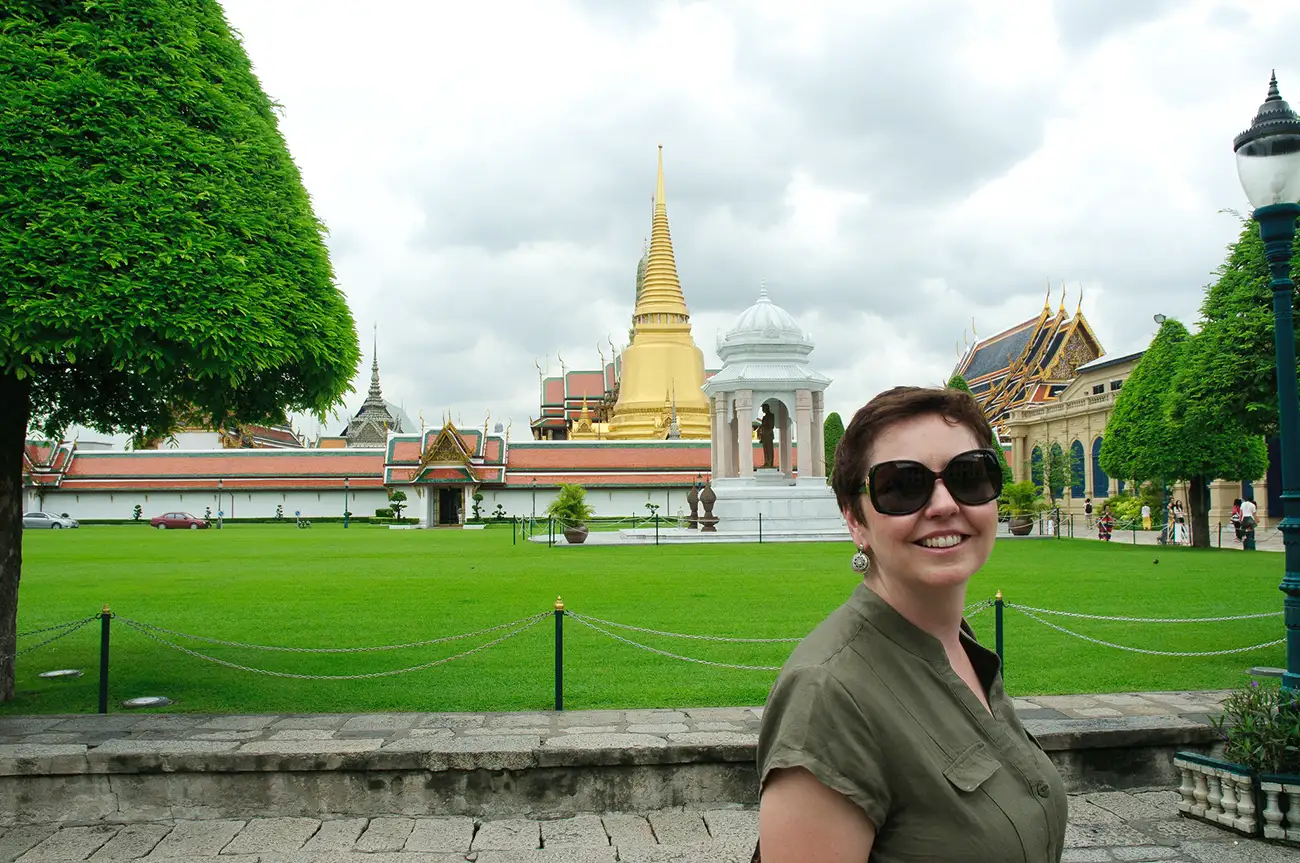
Dress Code: What to Wear at Bangkok Kings Palace
Visitors are required to follow a strict dress code upon entering the Bangkok Kings Palace. The guidelines ensure modesty and respect for Thai cultural values.
1. Cover Shoulders and Arms: Wear clothing that covers your shoulders. Sleeveless tops, tank tops, and halter necks are not allowed. For women, lightweight scarves or shawls can be a practical option if your outfit doesn’t meet the requirements.
2. Cover Legs: Shorts, short skirts, and ripped jeans are prohibited. Both men and women should wear long pants or skirts that extend below the knees.
3. Avoid Tight or Transparent Clothing: Clothing should be loose-fitting and opaque. Avoid see-through fabrics or tight garments that may be deemed inappropriate.
4. Footwear: Shoes are acceptable in outdoor areas but must be removed before entering certain temple sections, such as Wat Phra Kaew. Wearing slip-on shoes can make this process easier.
You can rent or purchase suitable clothing near the entrance if your attire doesn’t meet the dress code. Sarongs and shawls are readily available.
Visitor Etiquette: Do’s and Don’ts
To ensure you respect the traditions and sanctity of the palace, follow these key etiquette tips:
1. Speak Softly: The palace is a sacred and ceremonial space. Speak in low tones to maintain a peaceful environment, especially near Wat Phra Kaew.
2. Do Not Touch Sacred Objects: Avoid touching statues, murals, or other objects. These items hold immense religious and cultural significance. Even pointing at them can be considered disrespectful.
3. Observe Signs and Rules: Consider signs indicating restricted areas or photography bans. For example, photography is not allowed inside the temple housing the Emerald Buddha.
4. Follow the Flow of Foot Traffic: Stick to designated pathways and avoid disrupting other visitors’ movement. This helps maintain order and ensures a better experience for everyone.
- Show Respect to Monks: If you encounter monks, be respectful. Women should avoid direct contact with monks, as this is a cultural norm in Thailand.
Practical Tips for First-Time Visitors
- Plan Ahead: Check the palace’s website for updated visiting hours and ticket prices.
- Arrive Early: Morning visits help you avoid crowds and enjoy cooler temperatures.
- Stay Hydrated: Bangkok’s heat can be intense, so carry a water bottle.
- Use a Guide: A local guide can provide insights into the history and cultural significance of the palace.
Following the dress code and etiquette guidelines ensures a respectful and enriching visit to the Bangkok Kings Palace. These simple practices allow you to connect with the cultural and spiritual essence of one of Thailand’s most treasured landmarks. Respecting the rules enhances not only your experience but also the experience of others visiting this iconic destination.
Practical Information for Visitors
The Bangkok Kings Palace, also known as Bangkok’s Grand Palace, is one of Thailand’s most visited landmarks. To make the most of your experience, planning your visit carefully is essential. Here’s all the practical information, from opening hours to transportation tips.
Opening Hours and Entrance Fees
The Bangkok Kings Palace is open daily, including weekends and public holidays.
- Opening Hours: 8:30 AM to 3:30 PM
- Entrance Fee:
- Adults: 500 THB (includes access to Wat Phra Kaew)
- Children under a certain height (usually 120 cm) may enter free of charge.
Tickets can be purchased at the gate or online. It’s recommended that you book tickets in advance to save time. Please keep your ticket with you, as it may be checked at various points inside the complex.
Best Times to Visit
To enjoy the Bangkok Kings Palace at its best, timing is everything:
- Early Mornings: Arrive when the palace opens at 8:30 AM to avoid large crowds and intense heat.
- Weekdays: Mid-week visits are usually less crowded than weekends.
- Off-Peak Seasons: Visit during Thailand’s low tourist seasons (May to September) for a quieter experience.
Avoid visiting during Thai public holidays or significant royal events, as the palace may be closed or extremely busy.
Directions and Local Transport Options
The Bangkok Kings Palace is centrally located and easily accessible by various modes of transport.
1. BTS Skytrain and River Boat
- Take the BTS Skytrain to Saphan Taksin Station.
- From there, board the Chao Phraya Express Boat to Tha Chang Pier. The palace is a short walk from the pier.
- This is a scenic and stress-free way to reach the palace.
2. Tuk-Tuks and Taxis
- Tuk-tuks offer a fun and authentic way to travel but agree on a price before starting the ride.
- Metered taxis are widely available. To avoid being overcharged, insist that the driver use the meter.
3. Public Buses
- Local buses stop near the palace. Bus numbers 1, 3, 25, or 32 can drop you close to the site. However, buses may be less comfortable for tourists unfamiliar with the city.
4. Walking Distance from Nearby Attractions
- If you’re already visiting nearby landmarks like Wat Pho or Wat Arun, the palace is just a short walk or ferry ride away.
Tips to Avoid Crowds
- Arrive early to beat the midday rush.
- Use online ticket booking to skip long lines at the entrance.
- Visit during cooler months (November to February) for a more comfortable experience.
The Bangkok Kings Palace is a must-visit destination in Bangkok, offering a perfect blend of history, architecture, and culture. By planning with the above tips, visiting one of Thailand’s most iconic landmarks promises a smooth and memorable experience.
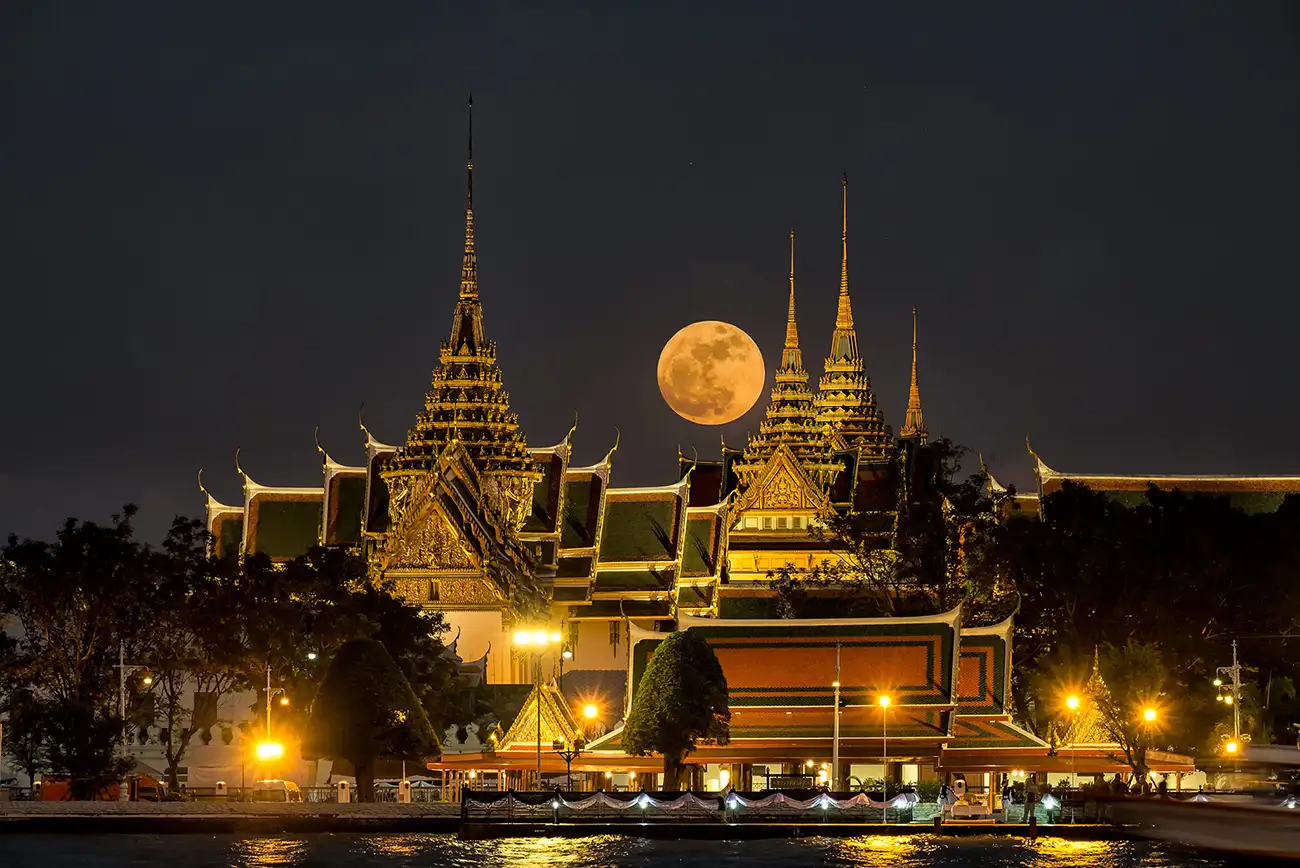
Photography Tips and Restrictions
The Bangkok Kings Palace, also known as Bangkok’s Grand Palace, is a photographer’s dream destination. Its intricate details, golden spires, and vibrant murals offer countless opportunities for stunning photos. However, knowing where and when photography is allowed ensures a smooth experience while respecting the palace’s rules.
Where and When Photography is Allowed
1. Allowed Areas
- Photography is permitted in most outdoor areas of the Bangkok Kings Palace. These include courtyards, gardens, and sections of the temple complex.
- Capture the beauty of the Chakri Maha Prasat Hall, Dusit Maha Prasat Hall, and other architectural highlights from the outside.
2. Restricted Areas
- Photography is strictly prohibited inside Wat Phra Kaew, particularly in the temple housing the Emerald Buddha. Respect the sanctity of this sacred space by putting away your camera.
- Signs indicating no photography are clearly displayed in restricted areas. Always adhere to these guidelines.
3. Best Times for Photography
- Early mornings (right after opening) provide the best light and fewer crowds.
- Late afternoons offer soft lighting and a serene atmosphere, making your photos more vibrant and detailed.
Recommended Camera Settings and Angles
1. Camera Settings
- Use a Wide-Angle Lens: Capture the grandeur of the palace’s architecture and its surroundings.
- Adjust for Lighting: Bangkok’s bright sunlight may require lower ISO settings (100-200) to prevent overexposure.
- Try HDR Mode: For a balanced exposure in areas with high contrast between light and shadow.
2. Angles for Scenic Shots
- Golden Spires and Rooflines: Photograph these from a low angle to emphasize their height and intricate details.
- Reflections in Water: The reflection pools create a mirrored effect of the palace’s iconic features.
- Detailed Close-Ups: Zoom in on murals, carvings, and decorative elements to highlight their intricate designs.
3. Smartphone Photography Tips
- Use Gridlines: Align architectural elements for perfectly balanced photos.
- Portrait Mode: Focus on details like sculptures or ornaments to create depth.
- Avoid Flash: Natural light is sufficient for most outdoor shots and prevents disturbance in sensitive areas.
Practical Tips for Photographers
- Respect the Rules: Always follow guidelines about restricted areas and avoid disrupting other visitors.
- Bring a Lightweight Tripod: A tripod can help capture stable, high-quality images. However, check for restrictions on tripod use.
- Pack Extra Batteries and Memory Cards: Long visits may drain your camera’s battery, so come prepared.
Photography at the Bangkok Kings Palace is an unforgettable experience. You can capture stunning memories of this iconic landmark by respecting the rules and using the recommended techniques. No matter what camera you use—professional or smartphone—the palace offers abundant opportunities to photograph its beauty.
Explore Nearby Attractions and Experiences
The Bangkok Kings Palace, also known as Bangkok’s Grand Palace, is surrounded by a vibrant area filled with cultural landmarks and unique experiences. Located on Rattanakosin Island, this area offers a rich blend of historical sites, spiritual havens, and culinary delights. Here are the must-visit attractions and activities near the palace.
Key Attractions Near Bangkok Kings Palace
1. Wat Pho (Temple of the Reclining Buddha)
Just a short walk from the palace, Wat Pho is one of Bangkok’s oldest and largest temples. The temple is well-known for its huge Reclining Buddha statue. This statue is 46 meters long and covered in gold. Traditional Thai massage also started at this temple. Take time to explore its beautiful courtyards, murals, and serene atmosphere.
2. Wat Arun (Temple of Dawn)
Located across the Chao Phraya River, Wat Arun is another iconic landmark. Its towering spires, adorned with colorful porcelain tiles, create a stunning silhouette, especially during sunrise or sunset. You can reach Wat Arun via a short ferry ride from the Tha Tien Pier near the palace.
3. Museum of Siam
Dive deeper into Thai culture at the Museum of Siam, a nearby modern museum. You’ll learn about Thailand’s history, traditions, and evolving identity through interactive exhibits. It’s an excellent spot for families and those curious about Thai heritage.
Cultural and Culinary Experiences
1. Local Markets and Street Food
The area around the Bangkok Kings Palace is bustling with local markets. Visit the nearby Tha Chang Market for street food delicacies like Pad Thai, mango sticky rice, and coconut ice cream. Vendors offer a variety of affordable dishes that let you savor authentic Thai flavors.
2. Riverside Dining
For a more relaxed experience, enjoy a meal at one of the riverside restaurants. Many places offer stunning views of the Chao Phraya River and iconic landmarks like Wat Arun. Try Thai specialties such as Tom Yum Goong or Massaman Curry while taking in the scenery.
3. Traditional Cultural Shows
Some venues near the palace host traditional Thai dance and puppet shows. These performances showcase Thailand’s artistic traditions and are a fantastic way to end your day of exploration.
Practical Tips for Exploring Nearby Attractions
- Use the Ferry System: Affordable and efficient, ferries provide easy access to attractions like Wat Arun.
- Wear Comfortable Shoes: You’ll walk a lot while exploring the area.
- Plan for Evening Visits: Some sites, like Wat Arun, are beautifully lit at night.
The area around the Bangkok Kings Palace offers a diverse mix of history, culture, and flavors. From the peaceful temples of Wat Pho and Wat Arun to the vibrant street food at local markets, there’s something for everyone. Add these nearby attractions to your itinerary to fully experience the charm of Bangkok’s Grand Palace and its surroundings.
Tips and Warnings for a Hassle-Free Visit
The Bangkok Kings Palace, also known as Bangkok’s Grand Palace, is one of Thailand’s most visited landmarks. While it promises a memorable experience, learning some practical tips and being aware of potential issues can make your visit stress-free. Here are essential tips and warnings to keep in mind.
Common Scams and How to Avoid Them
1. “Closed Palace” Scam
One of the most common scams near the Bangkok Kings Palace involves friendly strangers claiming the palace is closed for a private event or maintenance. They often suggest alternate tours or shops, which can be overpriced or unnecessary.
How to Avoid:
- Ignore these claims and check the official opening hours.
- Proceed directly to the ticket counter to verify access.
2. Overpriced Tuk-Tuk Rides
Some tuk-tuk drivers may offer a “special tour” of Bangkok for a low fare, only to take you to overpriced shops or unplanned stops.
How to Avoid:
- Discuss and settle on a fare with the driver before you depart.
- Use reputable ride-hailing apps or metered taxis for a safer option.
3. Pushy Vendors or “Guides”
Vendors or unlicensed guides may occasionally approach you to sell souvenirs or offer unofficial tours at inflated rates.
How to Avoid:
- Politely decline and continue with your plans.
- If you want a guide, hire one through an official source at the palace.
Staying Safe in Bangkok’s Heat
1. Stay Hydrated
Bangkok’s tropical climate can be challenging, especially during midday. Heat exhaustion and dehydration are common risks.
Tips:
- Stay hydrated and reduce waste by carrying a reusable water bottle and refilling it often.
- Seek refuge from the heat in shaded or air-conditioned areas as necessary.
2. Dress for the Weather
While adhering to the Bangkok Kings Palace dress code, use breathable fabrics such as cotton or linen to stay cool.
Tips:
- For extra protection from the sun, it’s a good idea to wear a hat and sunglasses.
- Apply sunscreen before heading out.
3. Avoid Midday Visits
The sun peaks between 11:00 AM and 2:00 PM, making this the hottest time to explore.
Tips:
- Plan your visit early or late in the afternoon to avoid extreme heat.
- Schedule indoor activities or breaks during midday.
Other Practical Advice
- Carry Small Change: Small bills and coins can be handy for tuk-tuk rides, market purchases, or restroom access.
- Keep Valuables Secure: Use a crossbody bag or backpack to keep your belongings safe.
- Follow Local Etiquette: Speak politely and always respect locals and fellow visitors.
Staying alert and prepared will make your visit to the Bangkok Kings Palace enjoyable and worry-free. Avoid common scams, prioritize your comfort in Bangkok’s heat, and follow these tips to make the most of your experience at this iconic landmark.
Conclusion
The Bangkok Kings Palace, also known as Bangkok’s Grand Palace, is an unmissable destination that captures the essence of Thailand’s rich history, culture, and artistry. From its stunning architecture to its deep spiritual significance, the palace offers a unique glimpse into the country’s royal traditions and Buddhist heritage.
Visiting the palace allows one to admire the intricate designs of the Chakri Maha Prasat Hall, Wat Phra Kaew’s serenity, and the surrounding attractions’ cultural vibrancy. It’s not just a tourist spot but a symbol of Thailand’s enduring legacy and connection to its past.
While exploring the palace, respect local customs and guidelines. Dress modestly, follow visitor rules, and embrace the cultural values of the Thai people. By doing so, you contribute to preserving the sanctity of this iconic landmark.
Whether you’re a history enthusiast, a photographer, or a casual traveler, the Bangkok Kings Palace promises a rewarding experience that leaves lasting memories. Make it a priority on your Bangkok itinerary and immerse yourself in the grandeur of Thailand’s royal heritage.
